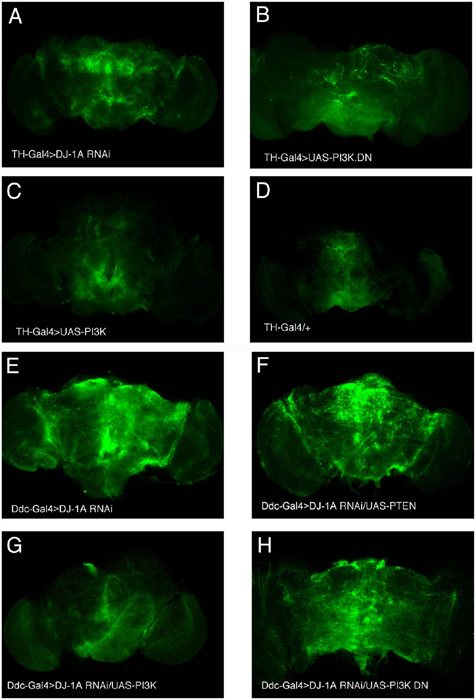
Yang et al. 10.1073/pnas.0504610102. |

Fig. 6. DJ-1A overexpression leads to resistance of H2O2-related oxidative stress. Survival curves of Da-GAL4/+ flies and Da-GAL4>UAS-DJ-1A flies that are treated with 100 mM 3-amino-triazole (3-AT) were compared. *, P < 0.01 in Student’s t test.

Fig. 7. Phosphatidylinositol 3-kinase (PI3K) signaling-induced modification of DJ-1A RNA interference (RNAi) phenotypes is accompanied by alteration of cellular reactive oxygen species (ROS) levels. (A-D) 2,7-Dichlorofluorescein diacetate (DCFH-DA) staining of whole-mount adult fly brain of the following genotypes: TH-Gal4>DJ-1A RNAi (A); TH-Gal4>UAS-PI3K DN (B); TH-Gal4>UAS-PI3K (C); TH-Gal4/+ (D). Note the specific ROS staining in neurons and their processes in A and B. The weak signal in C and D represents a combination of weak ROS staining and autofluorescence of the adult fly brain. (E-F) DCFH-DA staining of whole-mount adult fly brain of the following genotypes: Ddc-Gal4>DJ-1A RNAi (E); Ddc-Gal4>DJ-1A RNAi/UAS-PTEN (F); Ddc-Gal4>DJ-1A RNAi/UAS-PI3K (G); Ddc-Gal4>DJ-1A RNAi/UAS-PI3K DN (H). Note that the ROS staining is significantly stronger in PTEN coexpression flies (compare F with E), whereas the ROS signal is reduced to basal levels in PI3K coexpression flies (Compare G with E and D).